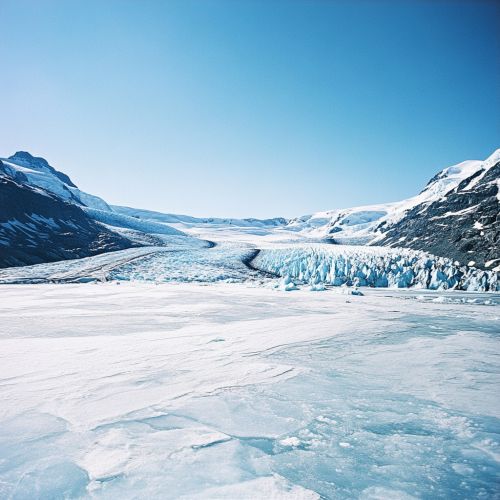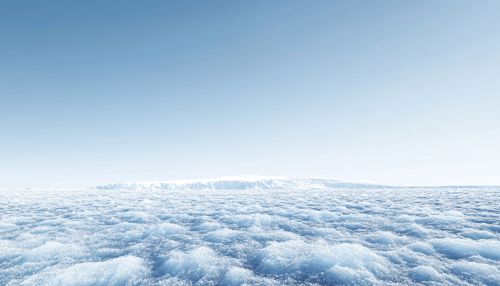Jutulstraumen Glacier: Difference between revisions
(Created page with "== Introduction == The Jutulstraumen Glacier is a significant glacial feature located in Queen Maud Land, Antarctica. It is one of the largest glaciers in the region, playing a crucial role in the dynamics of the Antarctic ice sheet. The glacier flows northward, draining a substantial portion of the ice from the interior of the continent towards the coast, where it feeds into the Fimbul Ice Shelf. Understanding the behavior and characteristics of Jutulstraumen is vi...") |
No edit summary |
||
| (One intermediate revision by the same user not shown) | |||
| Line 3: | Line 3: | ||
The Jutulstraumen Glacier is a significant glacial feature located in Queen Maud Land, Antarctica. It is one of the largest glaciers in the region, playing a crucial role in the dynamics of the Antarctic ice sheet. The glacier flows northward, draining a substantial portion of the ice from the interior of the continent towards the coast, where it feeds into the [[Fimbul Ice Shelf]]. Understanding the behavior and characteristics of Jutulstraumen is vital for comprehending the broader climatic and environmental processes at work in Antarctica. | The Jutulstraumen Glacier is a significant glacial feature located in Queen Maud Land, Antarctica. It is one of the largest glaciers in the region, playing a crucial role in the dynamics of the Antarctic ice sheet. The glacier flows northward, draining a substantial portion of the ice from the interior of the continent towards the coast, where it feeds into the [[Fimbul Ice Shelf]]. Understanding the behavior and characteristics of Jutulstraumen is vital for comprehending the broader climatic and environmental processes at work in Antarctica. | ||
[[Image:Detail-98299.jpg|thumb|center|A vast expanse of ice with a flowing glacier under a clear blue sky.|class=only_on_mobile]] | |||
[[Image:Detail-98300.jpg|thumb|center|A vast expanse of ice with a flowing glacier under a clear blue sky.|class=only_on_desktop]] | |||
== Geographic and Geologic Context == | == Geographic and Geologic Context == | ||
Latest revision as of 21:38, 8 October 2024
Introduction
The Jutulstraumen Glacier is a significant glacial feature located in Queen Maud Land, Antarctica. It is one of the largest glaciers in the region, playing a crucial role in the dynamics of the Antarctic ice sheet. The glacier flows northward, draining a substantial portion of the ice from the interior of the continent towards the coast, where it feeds into the Fimbul Ice Shelf. Understanding the behavior and characteristics of Jutulstraumen is vital for comprehending the broader climatic and environmental processes at work in Antarctica.


Geographic and Geologic Context
Jutulstraumen Glacier is situated in the eastern part of Antarctica, specifically within the region known as Queen Maud Land. This area is characterized by its rugged topography, with numerous mountain ranges and nunataks—peaks of rock protruding through the ice. The glacier originates from the Antarctic Plateau, a high, cold, and desolate expanse that forms the central part of the continent. The glacier flows through the Jutul Valley, which is flanked by the Sør Rondane Mountains to the east and the Gjelsvik Mountains to the west.
The geology of the region is predominantly composed of ancient metamorphic and igneous rocks, which have been shaped by millions of years of tectonic activity and glaciation. The bedrock beneath Jutulstraumen is a complex mosaic of gneisses, schists, and granites, providing a stable foundation for the overlying ice.
Glaciological Characteristics
Jutulstraumen Glacier is a fast-flowing ice stream, with velocities reaching several hundred meters per year in certain sections. This rapid movement is facilitated by the glacier's basal conditions, which include the presence of subglacial meltwater that acts as a lubricant, reducing friction between the ice and the bedrock. The glacier's dynamics are further influenced by the ice divide located at the Antarctic Plateau, which determines the flow direction of the ice.
The glacier is approximately 120 kilometers wide at its terminus, where it merges with the Fimbul Ice Shelf. The thickness of the ice varies along its length, with measurements indicating depths of over 2,000 meters in some areas. The mass balance of Jutulstraumen, which is the difference between accumulation and ablation, is a critical factor in assessing its contribution to sea-level rise.
Climatic Influence and Environmental Impact
The climate of Queen Maud Land is characterized by extreme cold, with temperatures often dropping below -30°C. Precipitation is low, primarily in the form of snow, which accumulates on the surface of the glacier. The accumulation rate is a key variable in determining the glacier's mass balance and overall stability.
Jutulstraumen Glacier plays a significant role in the Antarctic ice sheet's response to climate change. As global temperatures rise, the potential for increased melting and ice discharge from glaciers like Jutulstraumen poses a threat to global sea levels. The glacier's interaction with the Fimbul Ice Shelf is particularly important, as changes in the ice shelf's stability can influence the flow rate of the glacier.
Research and Monitoring
Scientific research on Jutulstraumen Glacier is essential for understanding its behavior and predicting future changes. Researchers employ a variety of methods to study the glacier, including satellite remote sensing, ground-based surveys, and ice-penetrating radar. These techniques provide valuable data on ice thickness, flow velocity, and surface elevation changes.
International collaborations, such as those conducted by the Scientific Committee on Antarctic Research (SCAR), are crucial for advancing our knowledge of Antarctic glaciology. Continuous monitoring of Jutulstraumen is necessary to detect any significant changes in its dynamics, which could have far-reaching implications for the global climate system.
Challenges and Future Directions
Studying Jutulstraumen Glacier presents several challenges, primarily due to the harsh and remote environment of Antarctica. Logistical difficulties, such as transportation and communication, complicate fieldwork and data collection efforts. Additionally, the extreme weather conditions pose risks to researchers and equipment.
Future research on Jutulstraumen will likely focus on improving our understanding of the glacier's subglacial processes and their impact on ice flow. Advances in technology, such as autonomous drones and improved satellite sensors, will enhance our ability to monitor the glacier in real-time. Understanding the complex interactions between the glacier, the ice shelf, and the ocean will be critical for predicting the future behavior of the Antarctic ice sheet.
